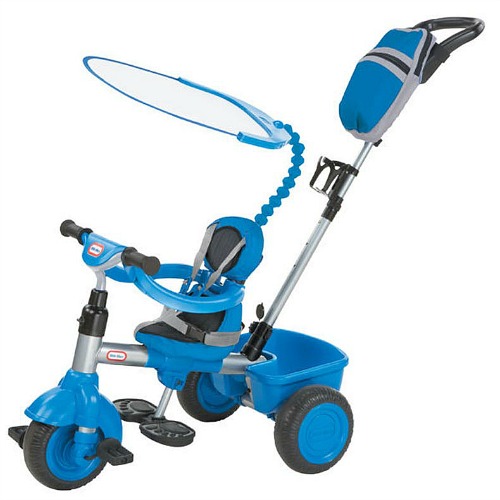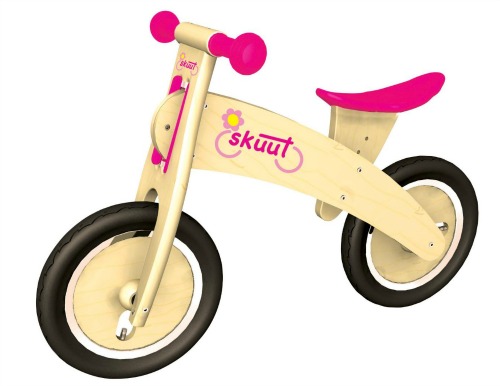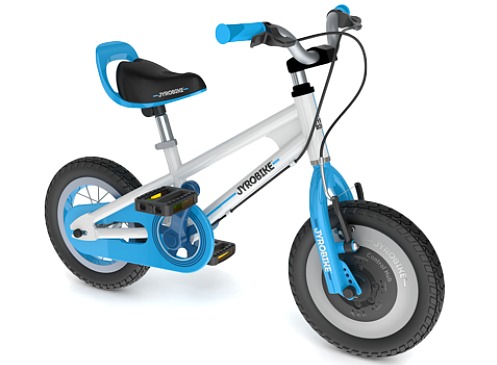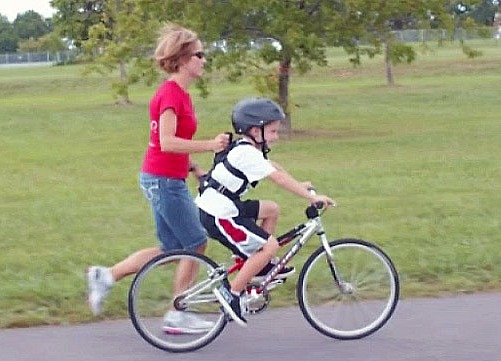Summer is here and, for many kids, learning to ride a bike is big on the summer bucket list! Learning to ride a bike will be a big achievement for your little one, and they will no doubt enjoy the new found freedom that they have unlocked! As a parent, teaching your child to ride a bike can be an equally exciting time but can also have its fair share of frustrations. Follow these tips on how to teach your child to ride a bike to help your child master the art of riding a bike while still keeping your sanity!
How do I know if my child is ready?
Like all tasks, a child will learn best if they are interested and motivated to do so. Remember that you want this to be a fun and exciting activity for your child! Generally, a child will typically learn to pedal a three wheeler around age 2 1/2 -3 years and can progress to a 2 wheeler {most often with training wheels to start} somewhere between 3 1/2-5. Remember that all children are different though, and will learn to ride in different ways depending on their skill level, physical abilities, and confidence. Always listen to and acknowledge any concerns or fears that your child may have and let your child take the lead. Some children will want to practice all day long and others will be done after a few minutes. Allow her to work within her comfort zone while providing some gentle encouragement to strive for that next level.
Get the right fit.
Learning to ride a bike will be SO much easier if your child’s bike is fitted correctly! I have put together some guidelines to follow for correct sizing but you can always check in with your local bike shop if you need further assistance.
Tricycle – If possible, it is always best to try out different trike options with your kiddos before making a purchase, as different children will do better with different bikes depending on their needs and size. It is also helpful if there are height adjustments on the bike since we all know how fast kids can grow! Remember that the pedals are often attached to the steering so when the child turns the wheel in one direction, one of the pedals will extend out even further requiring more leg extension. If your child has difficulty coordinating the steering and pedaling, some trikes {such as the Little Tikes 3-in-1} have the ability to lock out the steering so that your child can just focus on the pedaling. If your child has balance issues, look for a trike that is closer to the ground and sturdier built. Little Tykes 3-in-1 Trike
Little Tykes 3-in-1 Trike
Balance Bikes – Balance bikes {basically a bike with the pedaling system removed} have become increasingly popular in the last few years and there are a number of different models available on the market. If you do not want to purchase a dedicated balance bike, you can always just remove the pedals from a normal bike -you will just need to ensure that the seat will go down low enough {see below}. Balance bikes can be used in children as young as 18 months of age and can be a great way for younger children to develop balance and steering skills on two wheels. Theoretically, this should make the transition to a two wheeled bike {without training wheels} much easier as your child will already understand the key skills of balancing on two wheels. He will, however, still need to learn to pedal either on a tricycle or when he moves to a standard bike.
For proper seat adjustment, your child should be able to place his feet flat on the ground with his knees slightly bent while sitting on the seat. Depending on the brand of bike that you are using, some may have pegs or platforms for your child to put his feet up once he is more skilled on the bike.  Skuut Balance Bike
Skuut Balance Bike
Two Wheelers – Remember that you don’t need a fancy bike when your child is first learning to ride {we all know how quickly they will outgrow it!}. For the first bike, look for a smaller bike with a single gear and hand brakes. Your child should be able to stand over the bike with both feet on the ground and about an inch to spare over the crossbar. The seat height should ideally be adjusted so that there is still a slight bend in your child’s knee when the pedal is at the bottom of the cycle {although you can place the seat height slightly lower when first learning to ride if this makes your child more comfortable}.
Safety First
A helmet should be part of your basic bike gear from the very beginning. Talk with your child about simple safety rules and explain that the helmet needs to be on every time your child rides a bike. Be clear with him about where he can and cannot ride. For older children, review road safety rules and provide a bike light if allowed to ride after dusk.
Find an Appropriate Riding Area
When you are first teaching your child to ride a bike look for a quiet place with minimal vehicle or pedestrian traffic. A flat, fairly smooth surface will typically be best such as a quiet road, long driveway, tennis court or empty parking lot. If your child is nervous about falling, however, and on a balance bike or two wheeler {not a tricycle or bike with training wheels}, you could also start on a grassy surface with a minor downhill slope. A large open space will also be easier in the beginning because you don’t have to concentrate on steering as much.
Learning to Ride a Tricycle
For most children, the tricycle is often the first step in learning how to ride a bike. Start with showing your child the different parts of the bike and how to get on and off on their own {they may need some assistance with this initially but try to avoid just lifting them up and placing them on the seat yourself}. Tell them that they always need to keep their hands on the handlebars. There will be two main components that your child will need to master – steering and pedaling. Generally the steering will come first as many children have already learned how to steer when sitting on push toys. For the pedaling, they will first need to learn to keep their feet on the pedals while you help to assist them pedal. Once they are able to do this, they will need to build up the strength and coordination to be able to propel themselves without assistance.
Make sure that your toddler is only riding the tricycle on flat, firm surfaces. A tricycle’s high centre of gravity, combined with the fact that they have no brakes, makes it easier to flip over. Once your child is motoring around at a good speed, it is time to move to a two wheeler. If you child is still not ready to move on, a “big wheel” type tricycle that is closer to the ground will be a safer option.
Moving to a Two Wheeler
Once your child is ready to move to a two wheeler, you have a couple of options – a balance bike or a standard two wheeled bike {most often with training wheels first}. There are arguments for either being the better option so go with what your child is comfortable with and motivated to do!
Learning to Ride on a Balance Bike
- Learn to Balance while the bike is stationary. This might be easier to demonstrate if you are on your own bike. Show how to control the bike’s balance by turning your wheel to the right when the bike is falling to the right and turning the wheel to the left when it is falling to the left. Have your child try this and make a game of counting how long she can hold it for before putting a foot down.
-
Learn to “walk” the bike. While your child is sitting on the seat, have him move the bike by “walking” his feet on the ground. Encourage him to look up and forward where he is going rather than looking at his feet. As your child gets more comfortable, start to have him take longer strides and increase the force of the push off to build up more speed. If there are any hand brakes on the balance bike, encourage your child to use these to stop.
- Learn to “run” the bike. Once your child has learned to pick up some speed, the next step is for him to bend his knees and lift his feet just off the ground {keeping legs close to the body of the bike}. See if he can coast for a few moments before his feet touch the ground again. As your child progresses, practice doing this at slower speeds – coasting for longer distances and letting the bike almost come to a stop before braking or putting his feet down. Continue to practice this until he is able to maintain a 10 second glide {without putting feet down} 5 times in a row. Let your child get comfortable with this and steering {as well as braking if you have hand brakes} before moving onto pedaling.
Learning to Ride with Training Wheels
Even though your child was able to pedal a tricycle, the seat position will be different on a two wheeler, and they may need some time to practice learning how to pedal in their new position. Training wheels are often the easiest {and least painful!} way to learn how to ride a two-wheeler; however, they can also be the slowest, as children easily get accustomed to the support that they provide and take longer to learn how to balance themselves without this support. As with a tricycle, a bike with training wheels can actually tip over quite easily {especially with cornering} so speeds should be kept lower and the bike should only be allowed on flat surfaces.
To start, adjust the training wheels to the lowest setting that will still allow the bike to have a slight lean {so both training wheels are not in full contact with the ground at the same time}. As your child gains confidence and starts to master the art of pedaling and steering, gradually increase the height of the training wheels {this is better done in secret for some children!} so they are further from the ground. Encourage your child to keep the bike upright as much as possible instead of allowing the bike to fully lean onto one of the training wheels. Eventually they will start to learn balance and you can move on to removing the training wheels.
Learning to Ride a Two Wheeler Without Training Wheels
Children that have learned to ride on a balance bike may progress directly to a two wheeler without training wheels. If you child has never learned how to pedal on a tricycle, however, it might still be helpful to use training wheels to help them learn this task. When first learning to ride, keep the seat on the lower side so that your child can still easily put his feet down to the ground to maintain balance if needed.
First, you need to show your child how to position the pedals horizontally so he can easily get his foot onto the pedal to make it go once he pushes off. It often helps to begin this step on a very small downhill, grassy slope {if your child is able to coast easily down the slope without pedaling, it is too steep}. The extra boost from gravity can help your child get the hang of pushing off with their feet and getting the feet on the pedals to initiate pedaling. Repeat this multiple time until your child gets the hang of it. Encourage your child to use the brakes to stop rather than putting his feet down to the ground.
Once you child is pedaling down the hill and braking, you can start to add some steering. Start with just doing a turn in either direction at the bottom of the hill. Progress to riding in circles {on the flat ground!}. As your child gains skills and confidence, slowly start to raise the seat height back up to the appropriate height {see Get the Right Fit above}.
The other common method for teaching bike riding is running with your child as they pedal along. This does, obviously, require quite the workout on the parent’s part but can also be quite a quick way for your child to learn. You should hold the child by the shoulders {and NOT hold onto the handlebars} so that your child will receive input into their bodies as they start to lean to one side. This will allow your child to learn how to correct his balance more on his own, and will help him to progress faster to independent bike riding.
If you really want to use the “run beside your child” method to teach bike riding skills, but your child is taking longer than expected to learn, you may want to consider using a harness. It still provides the same input to your child as holding their shoulders but will likely save your back a lot of aches and pains in the process!
Other Options
If your child is not really into riding a bike yet, have him try a scooter {start with the three or four wheeled ones and progress to the two wheels}. It is a still a great way to teach him balance and he will be able to still participate and have fun with the other kids who are already riding their bikes.
The other new bike that is just out on the market, is the jyrobike. Basically, it has an electronic front wheel that will maintain the balance on the bike {remember gyroscopes from science class?} so training wheels are never required. The assistance from the wheel can gradually be decreased as your child learns to balance on his own. Sounds pretty cool to me and I would love to see one of these in action!

Jyrobike
Hopefully these tips will help your little one master the art of bike riding this summer. And if they take longer – that is okay too!
Remember that the most important part is to just HAVE FUN!!! 🙂

perfect timing for this post! How did you know? 😉
Just tonight I was noticing that Callum has gotten too tall for his training wheels bike. Looks like it’s time to buy him a big boy bike and work on riding it! We have a balance bike, but he’s really too tall for that too so his legs are super bent and it’s awkward. Jade, on the other hand, is so teeny that we bought her the smallest tricycle we could find and her toes barely reach the pedals. Haha. Very helpful article—thank you!
Wow! I’m glad I find your post about kid learning to ride a bike. My son was riding a balance bike like a pro. He grew up and it’s too small for him now. Just bought a real 16″ bike. The bike is bigger and heavier. He doesn’t feel safe. I will try with the small wheels like you suggest. Thank you for your tips!
I hope the tips help! If they are nervous, a slight decline on grass often works great.
Saving this for later! Our 3 year old has been really wanting to learn to ride a bike. My stepdad got her one with training wheels from a friend, but it is just way too big and scary. :/ She’s too big for her tricycle, so we really need a smaller bike with training wheels! Or a balance bike. She tried that once and loved it.
My youngest loved his balance bike – it’s funny how fast they can actually whip around on those!
Great tips! My son is used to riding a trike and now a two wheeler with training wheels so I think we’re going to try and transition him to a two wheeler without the training wheels. I’m not sure who’s more nervous about the whole thing him or me 🙂 Found your post at Inspire me Monday
Such a great milestone though! Good luck. 🙂
That wingman looks awesome. I’ve got 2 that are learning to ride. My 3-year-old JUST learned how to peddle her tricycle. I may have to get her a balance bike now. Thanks so much for the tips!
Good for your 3 year old! That’s a big skill to learn! Have fun teaching them!
Perfect timing as my daughter & SIL are in the middle of teaching our two granddaughters to ride. Passing this along 🙂
Oh good! Hope it helps!
Yup, this is exactly how I taught my boys to ride. A pediatrician in the neighborhood explained it this way and it really worked!
Glad to hear it worked for you! Smart pediatrician! 😉
What a great idea to post this! I’m afraid I scared my grand daughter when teaching her! Thanks for sharing with us at Throwback Thursday!
Mollie
To this day I still don’t know how to ride a bike. I wish my parents had this post with all it’s helpful ideas.
We employed Steady Rider to teach our 3-year-old how to ride a pedal bike. He went straight from a balance bike to a pedal bike (no training wheels). It was a great experience! We avoided crashes, tears, backpain (for us as adults) and enjoyed the process. We highly recommend it!
Thanks for the suggestion! I’m glad it worked well for you.